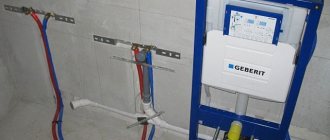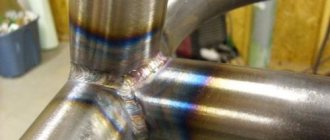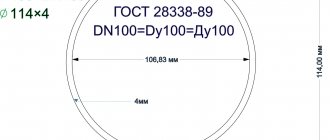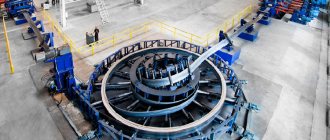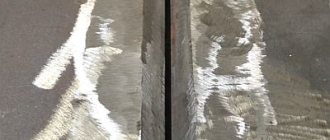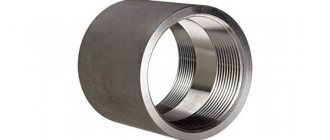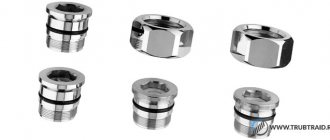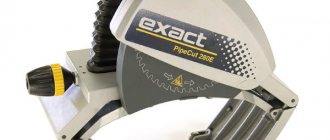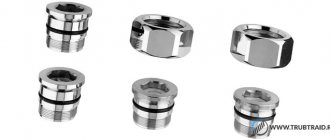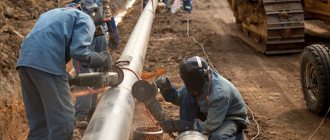Methods and types of chamfering from pipes and metal
A chamfer is the surface of a product that is formed during the processing of rolled products or pipes by bevelling the end edge of the material . A chamfer is needed to prepare the edges of sheets, beams and pipes for welding.
The main types of chamfer are:
- "Gas" . This is the cheapest type of bevel for a pipe due to its low properties. But the myth is one of the most widespread. This chamfer is removed using gas cutting machines of the CG-11 series. You will like the “Gas” chamfer that is made at the site of the breakdown. Its surface is usually with corresponding grooves formed from a gas stream (propane or acetylene).
- "Plasma" . From the outside, this type of chamfer is actually no different from “mechanics”. It also refers to “this is an air plasma cutter, compressor and plasma cutting machine CG2-11B, which makes the cutter move strictly in a circle when setting a precisely given bevel angle.
- "Mechanics" . This is a factory chamfer of the best quality. For cutting mechanical bevels, machines of the Mongoose series and TT bevelers are used. In the pipe trade, this same chamfer is mostly used due to the high-quality work of the chamfer.
Why do they chamfer? When welding workpieces, metal penetration occurs, which means that the edges are connected to each other. On the contrary, the thickness of the metal is more than just 3-5 mm, obtaining a complete and high-quality connection becomes difficult. To obtain high-quality penetration, this type of processing is carried out: it allows you to create a so-called weld pool, which is filled with a welding compound during welding. It is important to keep in mind that an edge prepared for welding is an edge with a chamfer and a bluntness (see the sketch and its designations below).
Values given in the diagram on the left:
R. dullness (in bold):
d. chamfer depth (cut depth) (leg):
w. chamfer width (in bold):
H. workpiece thickness
Dullness is usually 3-5 mm; it is needed to additionally guarantee the reliability of the weld. The blunting area, at the moment of filling the weld pool with the welding compound, melts itself, thus connecting the workpieces being welded together.
Types of chamfers (methods for cutting edges).
There are three main methods for preparing edges for welding: Y-shape, X-shape, and J-shape. From time to time in some sources they are designated by the signs: V, K and U, respectively. Hereinafter, the above methods will be designated by the following signs: Y, XJ In most cases, Y-shaped cutting of edges is carried out, but there is an X-shaped method. In special cases, when there is an excessive requirement for the quality of the weld, a J-shaped chamfer is used, in other words, a chamfer with a curved surface (not to be confused with a curved edge!).
Why is chamfering necessary?
Processing the ends of sheets or pipe walls is needed for:
- Good penetration and reliable connection of welding seams
- Reducing welding time
- Preventing injury to employees from sharp corners of the product
- Simplifying the upcoming installation of the metal structure being erected
- To avoid manual sanding of sheet or pipe edges
If chamfering is not performed, then in products whose thickness exceeds 5 mm, the welding seam may come apart over time and the structure will lose strength.
Bevelers for metal pipes overview
Metal pipe chamfering machines have been widely used since ancient times. Without a pipe chamfer, it is difficult to imagine the installation of any system, be it an oil and gas pipeline, boiler equipment, heating lines, water supply systems.
Despite the increased competition with plastic pipes, steel pipes have not lost their importance and they are still widely used in the laying of pipelines. One of the main roles is played by the bevel remover in preparation for installation and welding work on metal pipes.
Steel pipes require more careful preliminary preparation of the edge before welding than plastic pipes.
Summary of the article
The Mongoose series machines are manufactured to order from TechnoMashHolding and are known to consumers in more than 15 countries around the world. The Mongoose series of machines includes 4 models of bevelers for pipes with a diameter from 14 mm to 325 mm and are divided into 2 types based on the drive, which can be pneumatic or electric. This series of machines is the most reliable of all those available and produced on the Russian market, and is irreplaceable when performing repair work on power equipment, heat exchangers, boilers, and heating units. Mongoose chamferers allow you to remove internal and external chamfers for welding from the ends of pipes with a wall thickness of 30 mm or more, and remove the weld seam between the pipe and the tube sheet. Using additional accessories, you can drill pipes in boilers from the tube sheet, rolled pipes in heat exchangers, and cut fittings from thin-walled manifolds.
Features of bevelers for Mongoose pipes:
- are mounted in the inner surface of the pipe due to internal self-centering cams
- Replaceable jaws allow processing of a wide range of pipe diameters
- minimum flight radius
- simultaneous processing of the pipe end with several types of cutters is possible
- light weight and minimal installation time make it possible to use bevel cutters in places that are hard to reach and harmful to humans
Thanks to the large number of varieties of cutters, it is possible to perform almost any widespread bevelling option for pipes. Below is a table of pipes processed by the machines Mongoose-Midi-MT, Mongoose-Midi-Electro, Mongoose-2MT, Mongoose-2-Electro, Mongoose-200M3, Mongoose-200-Electro, Mongoose-325, Mongoose-325-Electro.
Watch all the videos of the Mongoose machine for chamfering pipes
Bevelers of the ISY, TT, P3-PG, TGM, TT-M (ZPK) series are designed to perform pipe facing operations, removing external and internal chamfers with a wall thickness of up to 75 mm and a diameter from 20 to 1500 mm. In the 2000s, machines called P3-PG were supplied to the Russian market; currently the equipment is known as the ISY and TT bevel remover. The presented models of pipe chamfers allow you to remove the external chamfer from pipes at 30 and 37 degrees, trim the end of the pipe at 0 degrees and chamfer the inside of the pipe at 15 degrees. Optionally, it is possible to order cutters for making a glass J chamfer R6 angle 10°, J chamfer R2 angle 15°, J chamfer R8 angle 20°. The ISY and TT machine is mounted in the inner part of the pipe using 3 self-centering cams; several cutters with different purposes can be installed in the tool holder and several operations can be performed simultaneously. The units can be supplied with a 220V electric drive, models ISY and TT, and a pneumatic motor P3-PG, TGM. The numerical index - 2 at the end of the machine marking indicates the wall thickness of the pipes being processed from 20 to 75 mm, with the index - 1 and without it up to 15-20 mm. The updated line of machines from model 1050 and higher are capable of processing pipes up to 120 mm thick and have a 380V drive.
We should also pay attention to the TT-M (ZPK) chamfering machines, which allow processing pipes with a diameter of 25-108 mm. Due to their dimensions and shape, these machines are perfect for preparing pipes before welding when installing boiler screens and pipes. Fastening to the pipe is done from the outside, using a special clamp and inserts.
Watch a video of the work of ISY, TT, P3-PG, TGM chamferers for chamfering pipes
Watch a video of the TT-M (ZPK) chamferers in operation for chamfering pipes
Chamferers for pipes Magnum (China)
Bevelers for Magnum pipes from Gazcut. The all-new design of the Magnum machines allows for increased pipe processing ranges with a single machine, and the body is made of aluminum, which helps reduce weight and avoid serious damage from impacts. The gearbox and engine have been improved, which has made Magnum machines reliable and unpretentious, and in some models it has become possible to install up to 3 cutters simultaneously.
The presented models of Magnum pipe bevelers allow you to remove the outer chamfer from pipes at 30, 37 and 45 degrees, trim the end of the pipe at 0 degrees and chamfer the inside of the pipe at 15 degrees. Optionally, it is possible to order cutters for making a glass J chamfer R6 angle 10°, J chamfer R2 angle 15°, J chamfer R8 angle 20°.
Promotech PRO series pipe chamfering machines are designed to perform pipe facing operations, removing external and internal chamfers with a diameter from 12 to 1000 mm.
Special attention should be paid to the stationary machine for chamfering PRO-40 PBS (PRO 40 PBS) from pipes in the diameter range from 200 to 1000 mm. Able to work efficiently, thanks to a high-speed rotating milling head with plates, chamfers up to 45 mm wide and angles from 0° to 60°. It is possible to remove the internal chamfer, including types J R6 and R8.
Types of chamfers
There are three ways to cut an edge from rolled metal:
- Y-shaped way;
- X-shaped;
- J-shaped (another name is “glass” chamfer);
- Also, in the technical literature you can find another letter designation:
V, K and U-shaped chamfer .
Features of different types of chamfers
- The most common methods of edge removal in production are the Y-shaped method and the X-shaped one.
- For a high-precision weld (for example, on products of complex design), a chamfer with a curved surface is used.
- J-shaped chamfer is performed using special automatic chamfers. This method creates a larger weld pool than other methods.
Other types of edge cutting
(butt type of connection with a broken edge) is not used so often in production.
Rolled metal ConcordMetal
offers chamfer processing services, including preparing the edges of metal sheets for welding. When performing this work, our specialists use highly efficient equipment with modern software, which guarantees the creation of the most accurate bevels of the end edge of the material. Complex and individual orders are completed quickly, in strict accordance with the technical specifications and wishes of customers.
Purpose of chamfer
To obtain a reliable and durable connection of any materials, it is necessary to create conditions for the interaction of particles on their surface. Using solid substances, it is quite difficult to achieve complete contact of particles.
Also, any raw material has roughness and tiny gaps. Therefore, practical adhesion of two surfaces does not occur completely, but only at individual points. Professional chamfering cleans the contacting edges and creates a large contact area (weld pool), which ensures a strong, high-quality connection between the surfaces of the material.
This is a necessary operation when preparing rolled products, pipes and beams for welding.
So, the chamfer is designed to solve several functions at once:
- Ensures the safety of items in use.
- Simplifies installation work.
- It gives some details an aesthetic appearance and serves as a decorative element.
- Protects the end edges of products from defects.
Types of jobs
The professionals of our company, having extensive experience and all the necessary equipment, will quickly and accurately remove the chamfer. You can order the service at any time convenient for you. Just call our managers and get detailed advice on the issues that interest you.
"ConcordMetal" carries out chamfering:
- from pipes
- from timber
- from polypropylene pipes
- from sheet metal
- ends
- metal sheets
In most works, the cutting angle is processed at an angle of 45 degrees, but our craftsmen can, at the request of clients, change these indications and perform chamfering according to your requests. The price will be negotiable, since the level of complexity of the task will be taken into account. If you need to carry out urgent chamfering, buying finished products with a chamfer removed is the fastest solution to the problem.
Features of the chamfering process
To cut edges on a metal product, special units are used - bevelers.
, differing in cutting method into three types (air-flame, mechanical and oxygen-gas equipment).
The edge cutting process is as follows:
- Using clamps, the chamfer is attached to the edge of a sheet or the inside of a metal pipe.
- Next, the required sharpening angle is set.
- When the machine is turned on, the cutting head is brought to the workpiece and the chamfer cutting process occurs.
- After finishing the work, the cutter returns to its original position.
- After chamfer cutting, the working surface of the product is considered prepared for further welding work.
When cutting a chamfer, a welding container (bath) is formed, where the hot welding composition is collected. A chamfered edge has a certain dullness of about 3-5 mm. When the container is filled with welding compound, the blunted area melts itself. Thanks to this, the required seam tightness is achieved and additional reliability is created.
About stripping for polypropylene pipes: how to do it yourself
To increase reliability and maximum pressure, polypropylene pipes have a reinforced layer. But it interferes with the formation of a high-quality welded joint. The solution is to strip polypropylene pipes before installing them.
Why is cleaning necessary?
The principle of welding pprc pipelines is to heat the polymer material to a viscous state. Then the hot pipe comes into contact with the coupling, resulting in soldering of the joint. However, reliability may decrease if aluminum foil used for reinforcement is in the contact zone. There will be no contact of polymers in this place, which can lead to depressurization.
The solution is to clean the reinforced pipes. Its features are as follows:
- Removing the foil layer at the soldering site will not reduce the maximum pressure value.
- If this is not done, gradual destruction of the joint is possible. The risk increases with frequent water hammer in the water supply system.
- Older models of polypropylene pipes have an outer layer of foil. Their diameter is 1.8-2 mm larger than the standard one. Without stripping, the pipe will not fit into the coupling socket.
A similar technology is used for all types of polypropylene pipelines. An exception is the use of products with fiberglass reinforcement. When heated, it partially melts and does not reduce the reliability of soldering. But for such models it is necessary to increase the heating time depending on the diameter.
Important: the heating temperature for pipes of different diameters is the same - up to +280°C. Contact time with a soldering iron is from 5 seconds (16 mm) to 80 seconds (160 mm).
Features of the material
When choosing a stripping method, you need to consider the end of the pipe. In standard wiring for cold and hot water supply and heating, the reinforcing layer is located in the middle, between the outer and inner layers. In older models it is located closer to the outside, protected from external influences by a thin layer of polymer. Its main function is not to increase reliability, but to reduce the thermal expansion of the pipeline.
Based on this, the following features of stripping for polypropylene pipes can be distinguished:
- The internal reinforcing layer will not be removed, but only the ends will be cleaned. This is necessary for soldering polypropylene.
- With an outer layer of aluminum, complete cleaning of the surface to a depth of 2 mm is necessary. The foil layer at the junction with the coupling is completely removed.
- Pipes without reinforcement do not need to be stripped or trimmed.
Removing part of the aluminum foil is necessary for all types of coatings - uniform and perforated. The reason is that metal heats up and cools down faster than plastic. In the contact zone, inhomogeneous crystallization may occur at the boundary with aluminum, which will lead to loss of mechanical resistance.
Tip: before starting stripping, the pipes should lie in the room at room temperature for 5-6 hours.
What are the tools for stripping polypropylene pipes?
Proper pipe stripping begins with tool selection. Its type and design depend on the type of reinforcement (external, internal) and diameter. For end brazing, special edge removal machines must be used. But polypropylene products are rarely made with a diameter of more than 60 mm. For this purpose, polyethylene pipelines are used.
Drill attachments
To install a pipeline with your own hands, you can buy several manual strippers for standard diameters - 16, 20, 25 and 32 mm. An example of a tool for external processing is the MasterProf or Newton series of models. Each is designed for two diameters, for example - 20x25 or 16x20. The knives are arranged vertically, they can be replaced and position adjusted.
Manual removal is convenient for small jobs. If this needs to be done en masse, it is recommended to purchase special drill attachments. They also differ in size, but all are designed to fit in a standard drill chuck. These are the optimal stripping tools for 20-25 mm polypropylene pipes.
How to choose manual or drill type cleaning:
- made of tool steel;
- corrugated surface for easy fixation;
- for manual models, the length of the knob is from 15 cm, it is possible to replace it;
- Drill attachments (shaver) can be of different diameters. This is achieved by adjusting the position of the blades.
An additional tool is a vice or clamp for fixing the pipe. This will make it more convenient to treat the surface; removal will not require much effort.
Working with a trimmer
A trimmer is necessary for cleaning the ends. It differs from attachments and shavers in the arrangement of the knives. Their plane is in a horizontal position at a slight angle. The aluminum layer is chamfered up to 1 mm. The advantage of this tool is its versatility. It is used to level the plane of the pipes, which affects the soldering accuracy.
Features of end trimmers:
- the ability to adjust the location of the knives, which will allow you to use one nozzle for pipes of several diameters;
- There are models for manual processing or installed in a drill;
- standard diameters are 20/25, 32/40 and 50/63.
The depth of chamfering depends on the evenness of the cut of the pipe. Often a trimmer is used first to level the plane of the end and then to clean the surface. Only a small part of the foil layer is removed, which eliminates its appearance at the soldering site.
Tip: according to reviews from craftsmen, plastic end caps have proven themselves well. They are suitable for arranging central and autonomous water supply and heating.
Edge cutting methods
Currently, two methods of edge removal are used in production: thermal and mechanical .
Mechanical chamfer
is considered the highest quality, since this method is performed on special equipment - beveling machines (edge cutters), milling machines, edge splitters and other devices. The advantages of this method are as follows:
- After chamfering, the product retains its structure and does not lose its physical and chemical properties.
- The mechanical method ensures high tightness and reliability of future welds
- Save time.
Thermal method
– air-plasma chamfer and gas-flame chamfer. Air-plasma cutting of edges allows you to obtain a chamfer appearance close to the factory (or mechanical chamfer). However, it requires a perfectly smooth surface of the sheet or pipes at a certain angle. In many industries, this type of chamfering is the main one due to its efficiency and high speed of processing products. It is performed using special plasma cutting equipment.
Gas-plasma chamfering
does not require special conditions for implementation and is characterized by low cost. But the quality of the cut is lower than with the mechanical or air-flame method. Often such chamfer cutting requires additional machining. This method is used for artisanal processing of used pipes. When using the thermal method of chamfer cutting (gas-plasma and air-plasma chamfer cutting), due to overheating, a section appears in the metal product with altered physical and chemical properties (thermal influence zone). This negatively affects the tightness and reliability of future welds and the strength of the structure itself.
Mechanical chamfering preserves the properties of the product and does not affect the quality of future welding work. Mechanical chamfering method
is a kind of guarantor of the quality of processing of metal products before welding. The only “disadvantage” of this method is the high cost of the units and the complexity of the work.
You can find out the cost of mechanical bevel removers by calling ☎ 8-800-555-95-28
Bevelers of the “Mongoose” series for pipes
Specialized chamfer removers
We cut the pipes correctly. Technologies for cutting steel pipes for welding
06.02.2019 11:40
The main routine operation when working with pipes is cutting the pipes into pieces of the same length. To do this, several thermal or mechanical cutting methods are used, but not all of them will provide the necessary cut quality for further welding of pipes. In this article we will analyze the optimal methods for cutting pipes and select the appropriate tools.
Cutting pipes is a weak point when installing pipelines
According to GOST 16037-80 (Welded joints of steel pipelines), a certain technology must be followed during welding. The chamfer shape is selected based on the diameter and wall thickness of the pipe and welding equipment. For example, when the pipe wall thickness is 4 mm and above, a V-shaped cutting of edges with a bevel angle of 30-35° is used.
To understand how the shortcomings of various pipe cutting methods manifest themselves, let’s put ourselves in the place of an installer and reproduce the entire process of repairing and laying a pipeline.
Example:
- Two hundred meters of steel pipe pipeline need to be laid at the site.
- At the beginning of work, electric-welded pipes with a diameter of 150 mm and a length of 5 to 9 meters are brought to the site. In accordance with the technical documentation, these pipes are cut into fragments of the required length.
- After cutting the pipes, their ends need to be prepared for welding. To do this, chamfering tools are used.
- After chamfering, welding work can be carried out.
Of all the above actions, workers spend the most time preparing the edge of the pipe - chamfering.
Quite often, pipe ends are processed at the pipeline laying site, and not in workshops or workshops, and unsuitable tools are used for this, for example, hand-held power tools. This is a very labor-intensive, dirty and noisy method, in which the cleanliness and chamfer angle leave much to be desired.
Let's look at the tools that help deal with this problem.
Automatic tools for pipe cutting and chamfering at the same time
When choosing methods for cutting pipes for welding, you should immediately exclude options with circular saws, grinding wheels and hand saws. These methods have low productivity and high cost of consumables. The quality of the edge remains unsatisfactory: with burrs, increased roughness and possible deformation due to the clamping vice.
Beveling machines
A high-tech alternative to the above tools would be electric or pneumatic beveling machines.
Pipe cutters
Electric pipe cutters can further optimize the cutting process. They are equipped with two cutters and combine two tools: one cutter cuts the pipe, the other simultaneously chamfers at the required angle.
Pipe cutters PTM
KOMAX pipe cutters
Constar pipe cutters
Standard models come with three bevel cutters that can bevel at 30, 37.5 or 45 degrees. All pipe cutters are supplied with two types of drives to choose from: pneumatic and electric.
Pipe cutters can be used with minimal reconfiguration for pipes with a diameter of 15 mm or more. This flexibility helps you use just one tool on a construction site instead of several specialized ones, and quickly switch to processing pipes of different diameters.
We cut and chamfer the pipe
The process of cutting and chamfering occurs as follows: a pipe cutter is attached to a piece of pipe, the cutters are brought to the edge of the pipe and the pipe cutter automatically begins cutting.
Depending on the diameter of the pipe, the entire process takes no more than 1–2 minutes, which is several times faster than cutting and chamfering with two different tools.
Advantages of electric pipe cutters
The use of specialized edge cutters and chamferers helps eliminate one of the weak points in pipe installation and speed up work, which is equally important during emergency and scheduled work.
Using professional tools, you will receive:
- Smooth and clean cut at the desired angle - without scale, burrs, etc.;
- Round pipe profile, no jams or deformations;
- Uniform material hardness along the edge.
When using professional tools - electric pipe cutters, chamferers and robotic welding machines - when laying pipelines, the labor productivity of emergency and installation crews significantly increases, which is important for both commercial construction companies and utilities.
If you have questions about equipment or need to choose a tool to solve your problem, contact our specialist in one of the following ways:
Source: https://obrabotkatrub.ru/articles/rezhem-trubyi-pravilno-texnologii-rezki-stalnyix-trub-pod-svarku.html
Cutting the internal thread
Then, it must be lubricated.
- Select a tap by diameter.
- Fix the tool in the hole. Remember that you must strictly observe the vertical position of the threading device. You must rotate the tap clockwise. Important to know!
The manufacturer must apply markings to each die. It specifies all the sizes of the grooves that can be cut using this tool. Before you begin work (watch a video on how to lay sewer pipes in different ways here), you should carefully study these data. If you need to cut threads on a stainless steel pipe steel, you will have to work a little more. Since stainless steel is a very hard material, the task becomes significantly more complicated.
Preparing to Carve by Hand
The pipe cut must be perpendicular to its walls. Otherwise, the threaded connection will not be reliable.
Sources:
https://andreypavlyuk.ru/kak-narezat-rezbu-na-trube https://stankotec.ru/raznoe/kak-pravilno-narezat-rezbu-na-trube-kak-narezat-rezbu-na-vodoprovodnoj-trube -obzor-sposobov.html https://msk-buhgalter.ru/kak-samostojatelno-narezat-rezbu-na-metallicheskoj/
